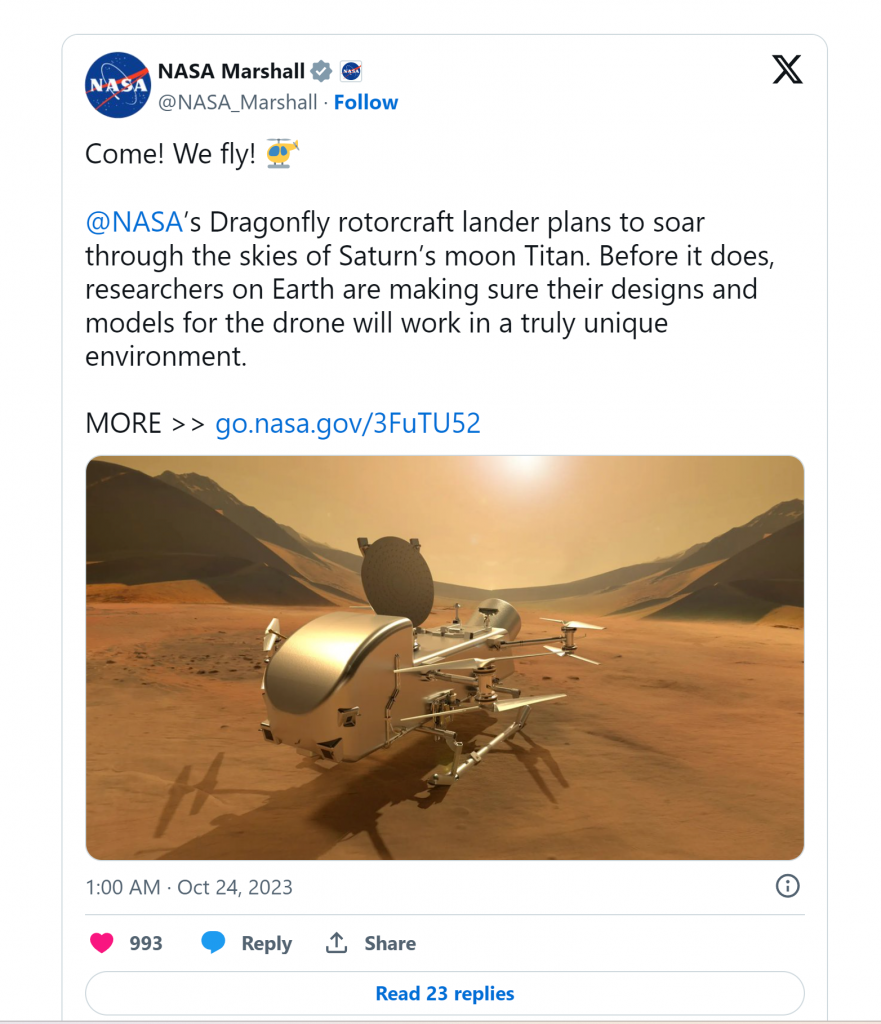Carding 4 Carders
Professional
- Messages
- 2,729
- Reaction score
- 1,521
- Points
- 113
NASA plans to study methane rivers and find alien life on Saturn's moon.
NASA continues to actively explore outer space, and this time scientists ' attention is focused on the largest moon of Saturn-Titan. To study this amazing celestial body, the Dragonfly rotary device was developed, equipped with eight propellers and comparable in size to a small car.

A team of researchers from the Johns Hopkins University Applied Physics Laboratory in Maryland conducted a series of tests of a prototype Dragonfly, reduced by half compared to the original. These tests were recorded on video and made available to the public.
It is worth noting that Dragonfly will be the first NASA mission to the surface of another oceanic world. Titan, like Earth, has a weather system with rivers, lakes, and seas on its surface. However, unlike Earth, Titan does not flow water, but liquid methane. Despite this, scientists suggest that Titan may be a potential habitat for alien life.
Dragonfly will explore the surface of Titan, discovering an ocean world that we know very little about. One of the advantages of the rotorcraft over NASA's Mars Ingenuity is that Titan has a significantly denser atmosphere than Mars, which means it will be easier to fly. It also has a lower gravity, so it will be less difficult to keep the Titan rotorcraft in the air.
Recent tests were conducted in wind tunnels at NASA's Langley Research Center in Hampton, Virginia. In a blog post, the space agency explained that in June, the Dragonfly team tested a half-scale model of the Dragonfly lander with eight rotors in the 14-by-22-inch subsonic Langley Tunnel.
Currently, the launch of Dragonfly is scheduled for 2027. If all goes according to plan, it will reach Oceanworld, Saturn's largest moon, by 2034.
"With Dragonfly, we are turning science fiction into research fact," added Ken Hibbard, Dragonfly mission systems engineer at APL, in a NASA post. "The mission is coming together piecemeal, and we look forward to every next step as we take this revolutionary rotorcraft across the skies and surface of Titan."

 www.youtube.com
www.youtube.com
NASA continues to actively explore outer space, and this time scientists ' attention is focused on the largest moon of Saturn-Titan. To study this amazing celestial body, the Dragonfly rotary device was developed, equipped with eight propellers and comparable in size to a small car.

A team of researchers from the Johns Hopkins University Applied Physics Laboratory in Maryland conducted a series of tests of a prototype Dragonfly, reduced by half compared to the original. These tests were recorded on video and made available to the public.
It is worth noting that Dragonfly will be the first NASA mission to the surface of another oceanic world. Titan, like Earth, has a weather system with rivers, lakes, and seas on its surface. However, unlike Earth, Titan does not flow water, but liquid methane. Despite this, scientists suggest that Titan may be a potential habitat for alien life.
Dragonfly will explore the surface of Titan, discovering an ocean world that we know very little about. One of the advantages of the rotorcraft over NASA's Mars Ingenuity is that Titan has a significantly denser atmosphere than Mars, which means it will be easier to fly. It also has a lower gravity, so it will be less difficult to keep the Titan rotorcraft in the air.
Recent tests were conducted in wind tunnels at NASA's Langley Research Center in Hampton, Virginia. In a blog post, the space agency explained that in June, the Dragonfly team tested a half-scale model of the Dragonfly lander with eight rotors in the 14-by-22-inch subsonic Langley Tunnel.
Currently, the launch of Dragonfly is scheduled for 2027. If all goes according to plan, it will reach Oceanworld, Saturn's largest moon, by 2034.
"With Dragonfly, we are turning science fiction into research fact," added Ken Hibbard, Dragonfly mission systems engineer at APL, in a NASA post. "The mission is coming together piecemeal, and we look forward to every next step as we take this revolutionary rotorcraft across the skies and surface of Titan."

Tunnel Visions: Dragonfly Team Tests Rotorcraft Designs in Unique NASA Facilities
Well before NASA’s Dragonfly rotorcraft lander soars through Titan’s skies, researchers at the Johns Hopkins Applied Physics Laboratory in Laurel, Maryland, ...
